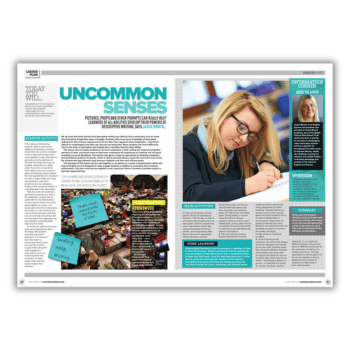Pictures, props and other prompts can really help learners of all abilities develop their descriptive writing techniques.
We all know that some learners find descriptive writing very difficult; this is particularly true for those who find taking imaginative leaps a struggle.
Students often have some knowledge of descriptive writing from their primary experience but all too often their approach lacks imagination. They find it difficult to contextualise and often ask ‘why are we doing this?’
Many students also find it difficult to ‘stick to the brief’ of description and instead take a narrative leap into storytelling.
Descriptive writing techniques
This lesson aims to inspire students to be more imaginative in their writing. It brings together elements of other curriculum areas to help them understand the importance of creativity and the place of writing across all disciplines.
The session also gives a range of approaches to widening vocabulary and developing sentence structures. This is vital to promote literacy across the curriculum and narrow the achievement gap between pupil premium students and their more affluent peers.
You can use the elements of this lesson together or as starters in a series of sessions both within and beyond English.
The lesson will engage students while also promoting academic achievement. This plan could also be adapted to suit a particular theme if students complete project- or thematic-based learning.
Learning objectives
- Understand what the five senses are and how to use them in your writing
- Develop your vocabulary
- Work in pairs effectively
- Write imaginatively using vocabulary and sentence structure for effect
Starter activity
This is about understanding students’ ability to pick out key details and vocabulary. Learners should enter the room to a detailed scenic image (and perhaps some music playing).
In pairs, they have to generate as many adjectives to describe the image and music as possible, writing them on sticky notes.
If you have a class that is lower ability, word cards could be given and students asked to select the most appropriate ones.
Equally if the class is higher ability you could ask students to write short sentences that are metaphors, similes or that use personification or onomatopoeia in their description.
Stick the words and sentences generated by learners to a wall, or the whiteboard, as they may be useful later for reluctant students.
It is also good to share some of the ideas together as a class – this should give a nice link to discussing the senses.
Many students will have only focused upon what they can see and hear. They will perhaps will not have taken the imaginative leap into what they could potentially taste, touch or smell.
It can also be useful here to have some pre-prepared lines about the image with students guessing which part it belongs to.
For instance, if you have shown a picturesque beach scene you may like to write a couple of lines about the birds engaged in a ‘harmonious chorus’. This reminds students that focusing in on small details really helps the reader imagine they are there.
Jackie Bowen is an English teacher and assistant vice principal at Cedar Mount Academy, part of the Bright Futures Educational Trust.










